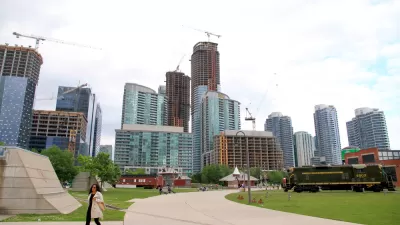The question of how and where to grow is causing controversy in Toronto. A recent op-ed picks a side.

An op-ed by Dave Wilkes, president and CEO of the Building Industry and Land Development Association (BILD), announces support for proposed changes to the controversial Growth Plan under consideration in Toronto.
For Wilkes, the question of whether to support the plan comes down to housing, and the current plan isn't building enough of it.
Much has been written about the proposed changes to the Growth Plan, the policy that manages growth in the Greater Golden Horseshoe. Many commentators have warned that the changes will bring more sprawl. By using that loaded word, they obscure the real issue we should be discussing: How do we build an adequate supply of housing for people in our region in a sustainable way?
Right now, we are not building nearly enough to accommodate the 115,000 people arriving in the GTA every year, and our worsening housing affordability attests to that. With the proposed changes to the Growth Plan, the provincial government is taking action to help increase housing supply while continuing to protect the environment.
According to Wilkes, the areas of the region targeted for growth are too resistant to new development for the plan to be effective. So density isn't being added to the areas with the transportation infrastructure to support it.
Instead, densification is being pushed to outlying areas of municipalities like Brampton, Vaughan and Pickering, on land designated for future development. Often, these areas are not served by transit, so residents have to drive, contributing to the traffic congestion and emissions that the Growth Plan was meant to alleviate.
Wilkes is responding to the position described in a news article by Ben Spurr from January of this year. Ontario Premier Doug Ford ran for office on a campaign platform that included a plan to expand the growth boundary surrounding the region.
FULL STORY: BILD: A lack of housing is the real issue

Study: Maui’s Plan to Convert Vacation Rentals to Long-Term Housing Could Cause Nearly $1 Billion Economic Loss
The plan would reduce visitor accommodation by 25,% resulting in 1,900 jobs lost.

North Texas Transit Leaders Tout Benefits of TOD for Growing Region
At a summit focused on transit-oriented development, policymakers discussed how North Texas’ expanded light rail system can serve as a tool for economic growth.

Why Should We Subsidize Public Transportation?
Many public transit agencies face financial stress due to rising costs, declining fare revenue, and declining subsidies. Transit advocates must provide a strong business case for increasing public transit funding.

How to Make US Trains Faster
Changes to boarding platforms and a switch to electric trains could improve U.S. passenger rail service without the added cost of high-speed rail.

Columbia’s Revitalized ‘Loop’ Is a Hub for Local Entrepreneurs
A focus on small businesses is helping a commercial corridor in Columbia, Missouri thrive.

Invasive Insect Threatens Minnesota’s Ash Forests
The Emerald Ash Borer is a rapidly spreading invasive pest threatening Minnesota’s ash trees, and homeowners are encouraged to plant diverse replacement species, avoid moving ash firewood, and monitor for signs of infestation.
Urban Design for Planners 1: Software Tools
This six-course series explores essential urban design concepts using open source software and equips planners with the tools they need to participate fully in the urban design process.
Planning for Universal Design
Learn the tools for implementing Universal Design in planning regulations.
Ascent Environmental
Borough of Carlisle
Institute for Housing and Urban Development Studies (IHS)
City of Grandview
Harvard GSD Executive Education
Toledo-Lucas County Plan Commissions
Salt Lake City
NYU Wagner Graduate School of Public Service





























